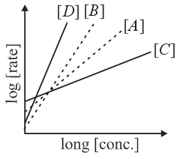The decomposition of in solution at has been studied by monitoring the concentration of in the solution. Initially the concentration of is and after minutes, it is reduced to . The reaction takes place according to the equation: .
Calculate the average rate of this reaction in terms of hours, minutes and seconds. What is the rate of production of during this period?
Important Questions on Chemical Kinetics
...(i)
...(ii)
The closest rate constant for the overall reaction
is:
In the following reaction;
‘A’ and ‘B’ respectively can be:
The initial concentration of is and it is after 30 minutes. The rate of formation of is:
The results given in the below table were obtained during kinetic studies of the following reaction:
| Experiment | Initial rate/ | ||
| I | |||
| II | |||
| III | |||
| IV | X | ||
| V | Y |
X and Y in the given table are respectively :
(i)
(ii)
(iii)
The overall order of the reaction will be
Rate
If the concentration of A is kept the same but that of B is doubled what will happen to the rate itself?
| Experiment No. | Rate of reaction | |||
The rate of the reaction for and is found to be The value of is __________

where,

and , are respectively, the rate constants for substitution and elimination, and , the correct option is ________
Consider the following reactions
The order of the above reactions are respectively. The following graph is obtained when log[rate] vs.log[conc.] are plotted:

Among the following, the correct sequence for the order of the reactions is :
If the concentration of is increased from , keeping the value of at , the rate constant will be:
| Initial Concentration (A) | Initial Concentration (B) | Initial rate of formation of C |
|---|---|---|
The rate law for the formation of is
For an elementary chemical reaction, , the expression for is:

